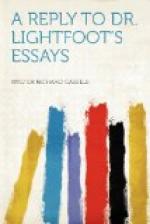Lardner says: “But whether the smaller
(Vossian Epistles) themselves
are the genuine writings of
Ignatius, bishop of Antioch, is a
question that has been much
disputed, and has employed the pens
of the ablest critics.
And whatever positiveness some may have
shown on either side, I must
own I have found it a very difficult
question.” The
opinion which he expresses finally is merely:
“it appears to me probable,
that they are for the main part
the genuine epistles of Ignatius.”
Beausobre says: “Je ne veux, ni
defendre, ni combattre l’authenticite
des Lettres de St. Ignace.
Si elles ne sont pas veritables, elles
ne laissent pas d’etre
fort anciennes; et l’opinion, qui me paroit
la plus raisonnable, est que
les plus pures ont ete interpolees.”
Schroeckh says that along with the favourable
considerations for
the shorter (Vossian) Epistles,
“many doubts arise which make them
suspicious.” He
proceeds to point out many grave difficulties, and
anachronisms which cast doubt
both on individual epistles and upon
the whole, and he remarks
that a very common way of evading these
and other difficulties is
to affirm that all the passages which
cannot be reconciled with
the mode of thought of Ignatius are
interpolations of a later
time. He concludes with the pertinent
observation: “However
probable this is, it nevertheless remains as
difficult to prove which are
the interpolated passages.” In fact it
would be difficult to point
out any writer who more thoroughly
doubts, without definitely
rejecting, all the Epistles.




